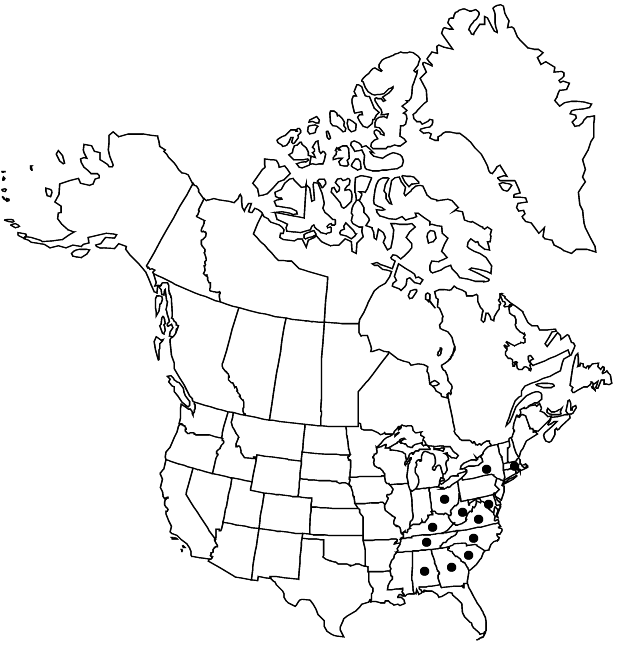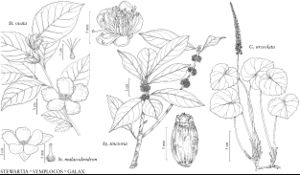Galax urceolata
Taxon 21: 309. 1972,.
Plants sometimes forming dense groundcover. Leaves: petiole 5–25 cm; blade 30–100 mm, base cordate. Scapes 20–40(–80) cm. Calyces 1.5–2.5 mm. Capsules 2.5–3 mm. 2n = 6, 12.
Phenology: Flowering May–Jul.
Habitat: Mountains, rocky woodlands, bald margins, rock outcrops and crevices, stream banks, hemlock to oak-hickory forests, piedmont, coastal plain, usually bluffs or moist slopes along streams, sometimes beech forests, associated with Kalmia latifolia or Rhododendron maximum
Elevation: (20-)500-1800 m
Distribution

Ala., Ga., Ky., Md., Mass., N.Y., N.C., Ohio, S.C., Tenn., Va., W.Va.
Discussion
Galax recorded from Massachusetts and New York apparently are naturalized or persistent garden escapes.
Diploid populations of Galax urceolata occur over most of its range—throughout the montane regions and onto the piedmont of South Carolina and the southern piedmont and coastal plain of North Carolina. Tetraploids occur exclusive of diploids on the coastal plain of Virginia and the northern piedmont and coastal plain of North Carolina. Along the Blue Ridge escarpment (North Carolina southward), the two cytotypes occur in complex patterns of sympatry, and triploids are abundant, even in some sites where plants apparently are otherwise only diploid or only tetraploid (G. L. Nesom 1983c; T. L. Burton and B. C. Husband 1999).
Compared to diploids, tetraploids tend to produce longer rhizomes, thicker scapes, larger leaves, and slightly larger flowers. For example, in the area of Highlands, North Carolina, leaves of tetraploids range to 15 cm wide, those of diploids to 10.5 cm; corolla size is 4.5–8 × 1.3–2.5 mm for tetraploids, 3.5–6 × 0.8–2.3 mm for diploids. It is sometimes possible to distinguish the cytotypes in the field; there apparently is little other morphological or phenological difference. The cytotypes sometimes appear to be ecologically sorted, with tetraploids occurring in more mesic sites, particularly in the mountains where diploids occur sympatrically. No differences in habitat are apparent on the piedmont and coastal plain. A hypothesis of autoploid origin of the tetraploids is supported by a study showing no significant variation in flavonoids (D. E. Soltis et al. 1983).
Selected References
None.
